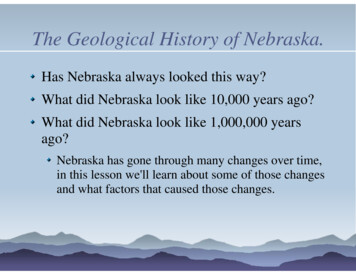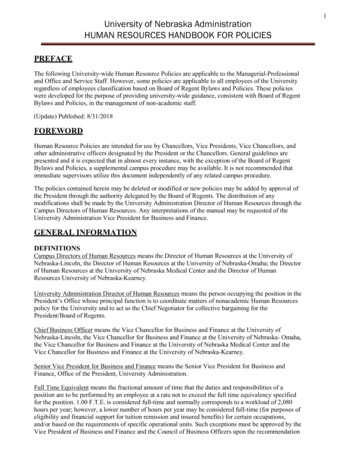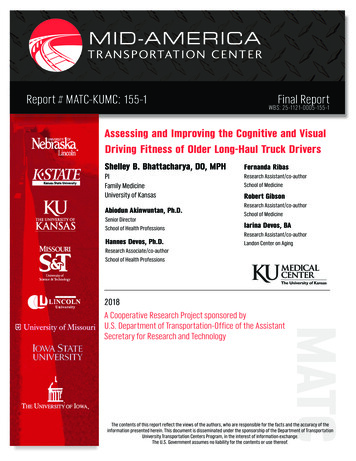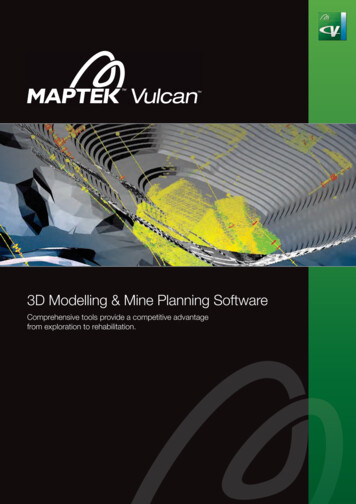
Transcription
The Geological History of Nebraska.Has Nebraska always looked this way?What did Nebraska look like 10,000 years ago?What did Nebraska look like 1,000,000 yearsago?Nebraska has gone through many changes over time,in this lesson we'll learn about some of those changesand what factors that caused those changes.
Basic Plate TectonicsThroughout Earth's history the surface featureshave been slowly changing.Vulcanism, earthquakes and weather have beenthree of the driving forces.But, the biggest driving force, and a cause ofsome of the other three, has been Plate Tectonics.In 1915, Alfred Wegener, a German geologist,published his theory of plate tectonics.
Basic Plate Tectonics (cont.)Wegener proposed that the shapes of thecontinents was due to them being at one timejoined.The crust of the Earth is segmented into severallarge plates, and that these plates move around onthe earths surface.Modern science has continuously proven thistheory to be true.The theory proposes that the continents have beenmoving around for all of earths history.
Basic Plate Tectonics (cont.)The movement of the plates, along with theorbital parameters of the earth around the sun,cause gradual changes on, beneath AND abovethe earth's surface.Movement of a plate toward the equator wouldmake it more tropical in today's world. Closer tothe poles would make it cooler.Separation of plates along fault lines might causea new ocean or sea to form, causing changes inthe local weather.
Basic Plate Tectonics (cont.)What would happen to the plants and animals ofNebraska if it became more tropical?What would happen if Nebraska become colder,almost arctic?What would happen if Nebraska were to becomecovered with an ocean of water?What would happen if large scale vulcanism wereto occur?All these things HAVE happened in the past, andNebraska WAS effected by them!
Basic Plate Tectonics (cont.)Geologist have tracked the movement of thecontinents over time by examining physicalevidence contained in the rocks.Magnetic alignment of minerals show's that thepoles have drifted, the very content of rocks cantell whether they formed in arid, tropical ormarine environments.Fossils contained in the rocks can tell us whetherthere was a connection between one land massand another.
Basic Plate Tectonics (cont.)In the following presentation/lesson we will trackthe movement of Nebraska across the Earthssurface throughout geologic time. We will seethe geologic and environmental changes that haveoccurred and discuss the way this may haveeffected the geology and life forms in the state ofNebraska over time.
Geologic TimeScientists divide Earths time lineinto three main time 'divisions'.Eons are Huge chunks of time.The Precambrian 500mya to 4.5Bya and the Phanerozoic *thePrecambrian is sometimes dividedinto the Proterozoic Archeozoicand HadeanEras are smaller divisions of time.We'll be concerned mainly withthree, the Paleozoic (540-248mya), the Mesozoic (248-65mya)and the Cenozoic (65mya Present)
Nebraska's Geologic HistorySo, What was Nebraska like during all these timeperiods?What kinds of climate did it have?What kinds of rocks were formed here?What kinds of organisms were found here?What kinds of landforms were present?What happened to change it all?To find out we'll break it down by time periods.
Nebraska's Geologic History: 650myaDuring this EraNebraska was not yettruly formed. Theworld was covered byseas with very littleexposed land mass.
Nebraska's Geologic History: 514myaAs time went on the amountof land become greater.Gondwana was the first ofthe 'super-continents'.Life forms become morecommon.Nebraska is covered withshallow seas.Paleozoic rocks are foundin only a couple spots inNebraska.Climate was tropical-subtropical.
Nebraska's Geologic History: 356myaNorth America (andNebraska) begins to 'takeshape'. (Yellow box)Most of continent is stillcovered by shallow seas.Enormous tropical forestsand swamps cover NA.Nebraska is still coveredmostly by shallow seas,swamps.Tropical climate.Mostly sandstones,shales, clays andlimestones. Little coal.
Nebraska's Geologic History: 306myaLater in the Paleozoic,NA is nearly formed.Large portions of dry landare present.Double-click to add graphicsSwamps and shallow seascover most of the worldand Nebraska.Local life included corals,molluscs, trilobites andfishes.Rocks formed were coal,limestones, sandstonesand clays.
Nebraska's Geologic History:255myaNA mostly formed, separating from Europe andSA. Inland seas drained.Nebraska became morearid, and the faunachanged to suit the newenvironment.Climate became moreseasonal.Plants and animalsadapted to the new world.Some limestones, claysformed during this period.
Nebraska's Geologic History: 237myaOnce again seas encroach onNA .Nebraska is an upland region,dry and eroding.Climate was hot and arid.Plants included conifers, treeferns and cycads.Animals included the newreptiles, fish and earlymammals.NO Triassic rocks are visiblein Nebraska. Mostlysandstones, shales formed.
Nebraska's Geologic History: 196myaLate Jurassic, midMesozoic, NA mostlyupland and dry land.Climate begins to cooland become drierReptiles become moreprevalent also birds andsmall mammals. Conifers,cycads become mostcommon.Seasonal changes becomemore pronounced.Sandstones, shales areformed.
Nebraska's Geologic History: 152myaNA almost complete and ismostly dry land now.First Dinosaurs appear,giant sauropods, first birds,and flowering plants.Climate was hot and humid.Dinosaurs, birds and smallmammals become common.Modern trees, plants beginto spread.Rocks formed aresandstones, and shales.
Nebraska's Geologic History: 94myaMid Cretaceous, LateMesozoic.Dinosaurs now 'rule',mammals and birds are small,modern trees and plants areprevalent.A new seaway opens fromGulf of Mexico to ArcticOcean.Climate is warm and humid.Shallow seaway coverswestern NE.Some chalks, limestones, andsandstones formed now.
Nebraska's Geologic History: 66myaThe END of the Cretaceous.Extinction of dinosaurs.Seas are beginning to recede.Most of Nebr covered byocean (no dino fossils :( )Dakota Group is laid downconsisting of sandstones,shales and some chalks.A 7mile long meteoritestrikes Gulf of Mexico,forming Chixulub crater andcausing massive extinction.Climate temperate marine.
Nebraska's Geologic History: 50myaMiddle Eocene epoch, earlyCenozoic period.NA almost as it is today.Mammals are becoming morecommon.Climate is moist temperate tosubtropical over most of NAbut in the center of thecontinent it is getting drier.Eocene age rocks are notvisible in Nebraska
Nebraska's Geologic History: 15myaNorth America 15myaMiddle of Miocene epoch.NA mostly dry uplands, similar totoday. Climate was warm andtemperate. Large lakes formed inmid-continent regions. Grasslandstake over what were forests.Rocks of this age are fine sandstonesand some limestone plentiful in NE!Many modern plants arose includingtrue grasses.Mammals take over the plains, horses,camels, rhinos, a new form calledtitanothere and carnivores.One of the most abundant was theOreodont.
Ashfall Animals from NebraskaThis mural on display at Ashfall State Park shows many of the animals that were common toNebraska during the Miocene. It includes four species of horse, rhinos, elephants, camels,deer and several species of birds. All were found at Ashfall. And all met their demise 12 mya.BUT this event was localized, the ash was from a Yellowstone eruption.
Nebraska's Geologic History: 8myaLate Miocene, Periods ofglaciation occur during thistime.Climate is temperate, warmsummers and cool winters.Mega Fauna is booming, 500 lbs.Sandstones, some limestones,sand and loess depositsbecome common.Vulcanism in the west wasalmost constant.
Nebraska's Geologic History: myaThe Pleistocene, this is themost recent time periodbefore the present.Continental drift continues,but the Earth looked much asit does today.Mega fauna is everywhere,modern bison, birds andhorses, elephants andmammoths to.Glaciation causes climate tobecome arid and colder.Sandhills sand dunes are inmotion, and loess depositsform.
Nebraska's Geologic History: 0.125mya'Modern' time, Pleistocene/HologeneEpoch.Intermittent iceages, glaciers cover Mostof NA. Glaciers as far as northern NE.Climate in NE is dry, cool.Sandhills dunes are still moving around.Loess deposits from along side the dunefields.Glacial till and morraines are left asevidence.Organisms move or adapt to the harshconditions.A pathway opens between the glaciersfrom Alaska into the middle of NA.MAN ARRIVES!!
Nebraska's Geologic History: TodayToday.Nebraskas climate is seasonalwarm summers cold winters.No new rocks forming in Nebrsandhills stabilize (@ 600 ya)Organisms are what we seetoday.The continents continue tomove and life continues toevolve.The Megafauna disappears.did man do that?
Nebraska's Geologic History: 306mya Double-click to add graphics Later in the Paleozoic, NA is nearly formed. Large portions of dry land are present. Swamps and shallow seas cover most of the world and Nebraska. Local life included corals, molluscs, trilobites and fishes.










